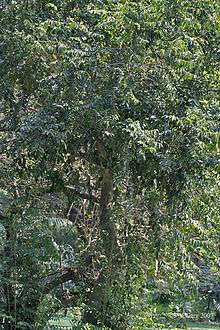Putranjivaceae
| Putranjivaceae | |
|---|---|
 | |
| Putranjiva roxburghii | |
| Scientific classification | |
| Kingdom: | Plantae |
| (unranked): | Angiosperms |
| (unranked): | Eudicots |
| (unranked): | Rosids |
| Order: | Malpighiales |
| Family: | Putranjivaceae Endl.[1] |
| Genera | |
Putranjivaceae is a rosid family that is composed of 216 species of evergreen tropical trees distributed into two genera.[2] Members of this family have 2-ranked coriaceous leaves, which, if fresh, typically have a radish-like or peppery taste. The flowers are fasciculate and usually small, and the fruits of these species are a single-seeded drupe crown by the persistent stigmas. This family has its origin in Africa and Malesia. It is the only family outside Brassicales that produces mustard oils.
Taxonomy
This family was formerly a tribe (Drypeteae) of the subfamily Phyllanthoideae in the Euphorbiaceae. When the Phyllanthoideae was separated to form the new family Phyllanthaceae, it was decided that Drypeteae also stand alone.
References
- ↑ Angiosperm Phylogeny Group (2009). "An update of the Angiosperm Phylogeny Group classification for the orders and families of flowering plants: APG III" (PDF). Botanical Journal of the Linnean Society. 161 (2): 105–121. doi:10.1111/j.1095-8339.2009.00996.x. Retrieved 2013-06-26.
- ↑ Christenhusz, M. J. M., and Byng, J. W. (2016). "The number of known plants species in the world and its annual increase". Phytotaxa. Magnolia Press. 261 (3): 201–217. doi:10.11646/phytotaxa.261.3.1.
http://www.britannica.com/EBchecked/topic/1446320/Putranjivaceae, Encyclopædia Britannica Online
| Wikimedia Commons has media related to Putranjivaceae. |